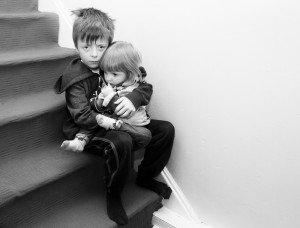
According to the World Health Organisation (WHO), somewhere between 25 and 50% of people may have been physically abused at some point during their childhood, an experience defined as the use of physical force that harms the child’s health, survival, development, or dignity. Childhood maltreatment does not stop at physical abuse, however – children may be emotionally or sexually abused or neglected – and these experiences can have lasting implications for the health of the adult.
The association between child sexual abuse and poor psychological health in adult life is now well established. However, the impact of exposure to non-sexual child maltreatment (physical and emotional abuse, and neglect) on long-term health outcomes has not been systematically examined.
A systematic review and meta-analysis published last year in PLoS Medicine (Norman et al, 2012) has now provided a better understanding of the association between exposure to physical abuse, emotional abuse, and neglect in childhood and mental and physical health outcomes in later life.
Methods
The authors conducted a systematic review of all publications in Medline, EMBASE and PsychINFO databases up to the end of June 2012 that investigated the relationship between child physical abuse, emotional abuse, or neglect and any health outcome. Importantly (and unusually for such reviews) articles in languages other than English were included (and translated). From this search, 124 studies were eligible for inclusion, the vast majority (112) from Western, English-speaking countries. Only 16 were prospective, longitudinal studies.
Results

Emotionally abused children had a 3-fold higher risk for developing depression and anxiety
- Physical abuse, emotional abuse, and neglect are causally linked to mental and physical health outcomes
- The strongest evidence was for mental disorders such as depression and anxiety. Emotionally abused children had a three-fold higher risk for developing these disorders (Depression; OR 3.06 [95% CI 2.43-3.85], Anxiety; OR 3.21 [95% CI 2.05-5.03]), but both physically abused (Depression; OR 1.54 [95% CI 1.16-2.04], Anxiety; OR 1.51 [95% CI 1.27-1.79]) and neglected (Depression; OR 2.11 [95% CI 1.61-2.77], Anxiety; OR 1.85 [95% CI 1.25-2.73]) children also had significantly elevated risk, with evidence that those experiencing more severe abuse or neglect being at the greatest risk.
- Similar effects of non-sexual child maltreatment were found on risk for eating disorders, drug and alcohol use, and suicidal behaviour.
- The only physical health outcome for which there was strong evidence for an association with non-sexual child maltreatment was sexually-transmitted diseases and/or risky sexual behaviour. These outcomes were around 1.7 times more likely in those with a history of abuse.
- Evidence for an association with chronic diseases such as stroke, obesity, arthritis and headache/migraine was weak and inconsistent.
Strengths and limitations

The main limitation of this meta-analysis is its reliance on retrospective data
The authors did do an excellent job of finding all the relevant evidence, and used a statistical model that allowed them to weight each study by quality. However, the main limitation to this meta-analysis is its reliance on retrospective data. Only 13% of the included studies were prospective in design (and nearly two-thirds of these are based on the same longitudinal cohort), which is likely to have introduced significant variability in the assessment and description of maltreatment. This means that the reported relationships may not be as specific as it appears.
Conclusion
The authors assert that:
There was robust evidence of significant associations between exposure to non-sexual child maltreatment and increased likelihood of a range of mental disorders, suicide attempts, drug use, STIs, and risky sexual behaviour.
In this regard, neglect seems to be as harmful as physical and emotional abuse, and this emphasises the need for preventive strategies and for making such prevention a political priority globally.
Links
Norman RE, Byambaa M, De R, Butchart A, Scott J, et al. (2012) The Long-Term Health Consequences of Child Physical Abuse, Emotional Abuse, and Neglect: A Systematic Review and Meta-Analysis. PLoS Med 9(11): e1001349. doi:10.1371/journal.pmed.1001349
Andrews et al (2004) Child sexual abuse. In Comparative quantification of health risks: global and regional burden of disease attributable to selected major risk factors (PDF) (Ezzati et al, editors). WHO, Geneva; pp 1851-1940


Neglect may be as harmful as physical and emotional abuse, according to new systematic review – http://t.co/6roFIVCFnD
Pls RT @barnardos Neglect & abuse in childhood is linked to mental & physical ill health in later life http://t.co/UGgDxHkPhG
Via @mentalelf: Neglect may be as harmful as physical and emotional abuse, according to new systematic review http://t.co/rzgRLY9geP
My first blog for @Mental_Elf: Neglect may be as harmful as physical and emotional abuse, http://t.co/fZRF9rc8a5
@stephenwood8 Looking forward to reading it! New blogpost for @Mental_Elf is high on my to do list…
@StephenWood8 @Mental_Elf Gr8 article Stephen! :-)
Neglect may be as harmful as physical and emotional abuse, according to new systematic review http://t.co/xPXgP7v5rm via @sharethis
Review: emotionally abused children have a 3-fold higher risk for developing depression and anxiety http://t.co/UGgDxHkPhG
Emotional abuse in childhood leads to threefold risk of depression and anxiety says meta analysis.
http://t.co/QZObHcTDpd
RT @mental_elf: Review: emotionally abused children have a 3-fold higher risk for developing depression & anxiety http://t.co/Fx5HkDacFC
Neglect may be just as harmful as physical & emotional abuse, by
@StephenWood8 on @Mental_Elf http://t.co/d1dj8QdIzi #mentalhealth #MHUK
Neglect may be as harmful as physical and emotional abuse, according to new systematic review http://t.co/W7GRUgN4y4 via @zite
Read our blog on a new @PLOSMedicine systematic review about the long-term health effects of neglect & abuse http://t.co/UGgDxHkPhG
#Neglect may be as #harmful as #physical and #emotional abuse, according to new systematic review http://t.co/1BWh1p68EL @LegalAdvocateC
Review: non-sexual child abuse is linked to eating disorders, drug and alcohol use, and suicidal behaviour http://t.co/UGgDxHkPhG
Neglect may be as harmful as physical and emotional abuse, http://t.co/cKysdN0BRt via @sharethis
“evidence of [strong assoc] between [childhood emotional abuse] and incr likelihood of a range of mental disorders” http://t.co/JkyMQc4oVB
http://t.co/S6TMq2wbwi http://t.co/naQZVL9Ret
I’m interested as no mention of Personality Disorders.. Oh I know they don’t exist !!! http://t.co/6H7VptXKJD
[…] Les omtalen i The Mental Elf her […]
[…] for The Mental Elf, I reported on a systematic review and meta-analysis of the association between exposure to childhood maltreatment and later mental and physical ill health. That demonstrated a link between physical abuse, emotional abuse, and neglect, with poor mental […]